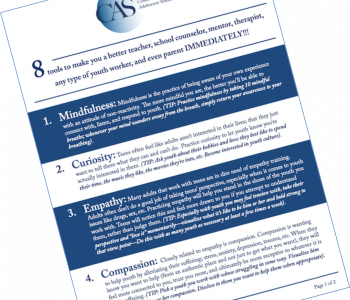


Sam Himelstein, PhD
Sam Himelstein is the founder and CEO of the Center for Adolescent Studies, Inc. He is passionate about working with youth and training the professionals that serve them.
2 Tips for Working with Resistance and Traumatic Adaptations
Many youth who’ve been impacted by trauma are resistant to therapy. Their self-protective behaviors and reactions are often misperceived as deliberately rebellious or disruptive. Because of this misunderstanding, the therapist may become angry, frustrated, anxious, or uncomfortable. These types of reactions tend to make the youth feel even less safe and therefore more aggressive or withdrawn.
Fortunately, there are ways therapists can moderate our own reactions in order to improve relationships and outcomes with youth who resist our interventions. In this post, I’ll explain more about traumatic adaptations and share a couple of strategies that have worked particularly well with my clients.
Two Basic Types of Traumatic Adaptations
Traumatic adaptations are the psychological and behavioral mechanisms that an individual unconsciously uses to cope with trauma, by protecting them psychologically from unconscious material that may be too difficult to deal with. There are many ways such resistance can manifest itself, but it can be useful to think in terms of the opposite extremes. At one end of the spectrum would be a youth who becomes aggressive. At the other end of the spectrum would be a youth who completely shuts down.
Aggressiveness can be a way to shield oneself from further attack. If that doesn’t work and the youth continues to feel threatened, or gets triggered even further, he or she could easily become triggered out of the window of tolerance and into hyper-arousal and attack or “fight” mode. Over time, these mechanisms form into the armor that adults see: defensiveness, resistance, disruptive behavior, and so on.
In other cases, a person who’s experienced trauma can shut down emotionally and appear bored or passive. Physical apathy may have protected them against abuse, so emotional apathy feels like a protection from further harm.
2 Important Guidelines for Addressing Resistance to Therapy
- Manage Your Tone of Voice.
When therapists feel uncomfortable, our tone tends to unconsciously rise in volume and sharpness. When working with youth impacted by trauma, this sharp tone could trigger a client’s protective mechanism into full dysregulation. It’s important to consciously regulate our volume and tone (as well as other factors like our body language), to help the youth stay in the window of tolerance.
My favorite way to manage my reactions is through a practice I call TAP, which helps me to think about what I’ll say in response, and how I can say it in a way that will be helpful rather than causing further harm:
First, I Take a breath,
Then, I Acknowledge my experience (e.g., flustered, angry, etc.), as well as acknowledging that the youth is likely resistant because of self-protection against further trauma.
After that, I can Proceed with mindful intention.
- Ask Questions Instead of Giving Orders.
When you make a statement like “please sit down,” youth who’ve been traumatized may hear that as “SIT DOWN OR ELSE!” since neutral and non-threatening stimuli can at times be interpreted as threatening and dangerous. Questions have a tendency to bring them back into their cognitive function and ponder a response, rather than the natural pushback on what can feel like a demand.
Case Studies: Martin and Jeannette
While it manifested in opposite ways, Jeannette and Martin (both pseudonyms) had both developed unconscious patterns that contributed to how they were viewed by therapists, teachers, probation officers, parents, and other people in their lives. Through managing my tone and asking questions, I was able to gradually develop a trusting relationship with them and help them become more conscious of their reactions and behaviors.
Martin
It was clear from our first meeting that Martin was resistant to therapy.
I don’t need this therapy shit. I’m good …You’re not gonna understand my life. My gang, you’re not gonna understand it. Drugs, I’m not stopping. I’m not gonna change.
I could have easily gotten triggered at this point. My false self of authority was challenged and it would have been easy to fall into the trap of thinking I needed to control the interaction so that Martin could “get what he needed” out of therapy. Instead, my first goal with Martin was to deescalate the tension.
I took a moment to calm and center myself, then said, in a calm, supportive tone of voice:
I hear you, and I just want to let you know I’m not going to try to tell you what to do or judge you. I’m not even here to tell you to stop using or stop being in a gang. I may not understand your life right now but I’d like to at some point, when you feel it’s okay. I’m just here to help you reach whatever goals you have, if any, and build self-awareness. As a matter of fact, I’m not even too worried about doing ‘therapy’ right now. Maybe we can just play some cards or watch some clips on the Internet. How’s that sound for now?
As you can see, rather than making a demand, I asked him a question about how he wanted to proceed. I essentially validated his experience and gave him a sense of agency.
After my introductory speech, Martin said, “Okay, whatever.” That might not have been a very enthusiastic response, but it was a lot better than where we started!
I got out my cards and taught him a game (as an INCRA), in order to get his mind off the fact that he was in therapy when he really didn’t want to be there. Martin liked the game, and after a few minutes I started asking him casually about his interests. Over the next few sessions I gradually earned his trust enough that he started opening up to me about the issues in his life. That likely wouldn’t have happened if I’d pushed him too hard to ‘do therapy’ in the first session.
Jeannette
Jeannette had been through a multitude of traumatic experiences. She grew up in an impoverished neighborhood, where she witnessed countless acts of violence. She’d been physically and sexually abused, and most of her family members were addicted to drugs.
Her way of coping was to completely shut down and dissociate from her experiences. She didn’t appear to care about school, her future, or much about life at all.
Sam: “How’s your day been?”
Jeannette (a disinterested, unemotional look on her face): “I just don’t give a fuck. I’m done with this therapy thing.”
At that point, I could have lectured her about the importance of therapy to her recovery from trauma. Or I could have felt personally attacked if I over-identified with a particular therapeutic outcome. Either of those reactions would likely have exacerbated her resistance in that moment and could have even led to dissociation and hypo-arousal.
Instead, I paused briefly and practiced TAP, which helped me interpret her statement as self-protection. As with Martin, I was careful in regulating my tone of voice, and I asked an open-ended question. My most important goal in that moment was to be a calm, supportive presence so she wouldn’t feel threatened and shut down even further.
Sam: “What is it about today that’s making you not give a fuck?” (I tend to mirror back my clients’ own phrasing. If you’re uncomfortable using this type of language, you could say something like: “Why do you feel like you don’t care about anything today?”)
Jeannette: “I don’t know. Just these stupid school people … Whatever…”
Sam: “What’s under that ‘whatever’?”
Jeannette: (She pauses and looks annoyed with me.) “I guess I’m just mad right now. Mad at the school principal.”
Jeannette went on to tell me about what happened earlier in the day and became frustrated while she was talking about it. The visible frustration was actually a good thing given that her protective mechanism was to slip into detachment. The open-ended questions helped to unearth what she was authentically feeling. At this point, I felt it was appropriate to talk to her directly about her experience and ask a yes/no question to confirm that she understood.
Sam: “I just want to name something that I think is important that happened here. When we first started off, your words were that you were in that ‘I don’t give a fuck’ mode. Then, it came to light that the feeling you were authentically experiencing was anger, is that right?
Jeannette: “Yeah.”
Sam: “That was you unearthing what you were really feeling in the moment. That’s you practicing authenticity and being emotionally intelligent. It’s hard for most, myself included, to break past the automatic thoughts and patterns, the ‘I don’t give a fuck’ attitudes that come up and really become aware of what’s really going on underneath.
Jeannette: “I guess I never thought about it like that.”
Sam: “That’s an extremely resourceful skill.”
Jeannette left therapy that day in a less resistant mood and with a better understanding of her own protective mechanisms. As with Martin, this positive development likely wouldn’t have happened if I’d taken offense at her initial resistance.
Conclusion: The Importance of Personal Practice
Despite many years of working as a therapist, I still have to remind myself sometimes that disruptive behaviors and resistance can have their roots in trauma and that such behaviors are protective mechanisms. When I view the initial resistance to therapy as protection, everything changes. I ask myself questions like, “I wonder what Martin is protecting right now?” and “That statement seems out of nowhere for Jeannette. What could she be protecting?” My whole attitude shifts away from authority, power dynamics, and feeling offended. Instead, I’m reminded that the vulnerable young people I work with have developed these coping mechanisms for a reason.
It’s essential that therapists and other helping adults have our own personal practices (such as TAP) ready to implement whenever we need them. We can activate the power of mindfulness to be more self-aware and more skillful in our responses when youth inevitably press our buttons. Sometimes the best way we can help them is through simply (if not always easily) maintaining a calm, supportive presence.
Your Turn
Have you encountered resistance from one of your patients, students, or clients? How did it manifest itself? How did you handle the situation? Did it go well, or do you wish you’d handled it differently? Are you currently facing a lot of resistance from a patient, student, or client? Post a comment and share your tips, questions, or experiences.
If you found this information useful, you may also be interested in the following posts:
- 4 Qualities That Lead to Interpersonal Connection and Safety with Youth
- How Our Own ACEs Impact Trauma Work with Youth
- The 4 Essentials of Being a Trauma-Informed Youth Professional
- 3 Tips for Working with Resistant Teens
You might also benefit from Heart Spring, an online community for helping professionals to continually evolve self-care and resilience practices, learn skills to bring to those they work with, and connect to a larger helping community.

